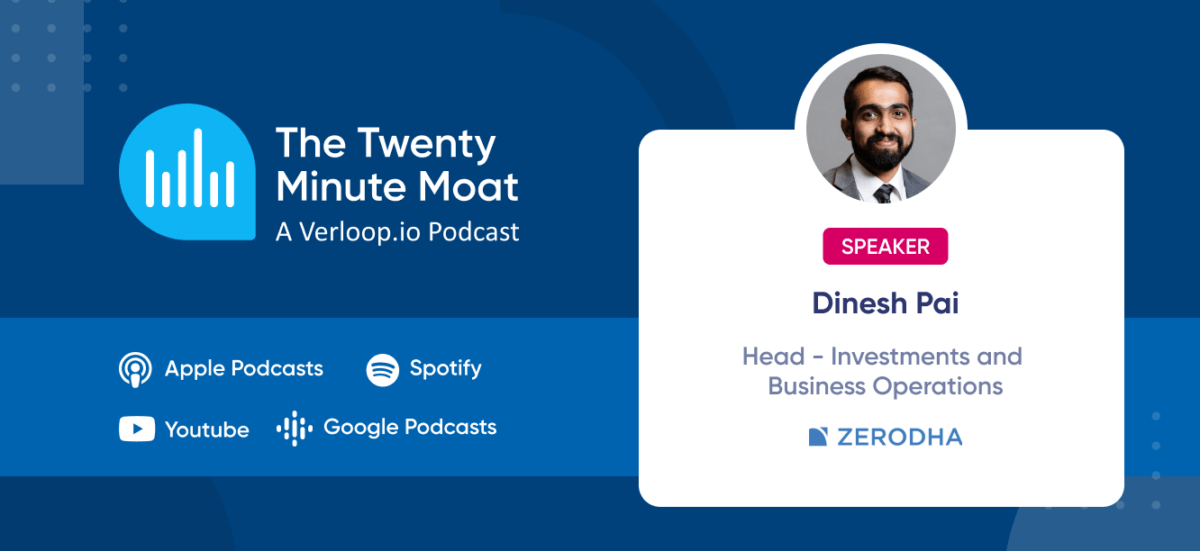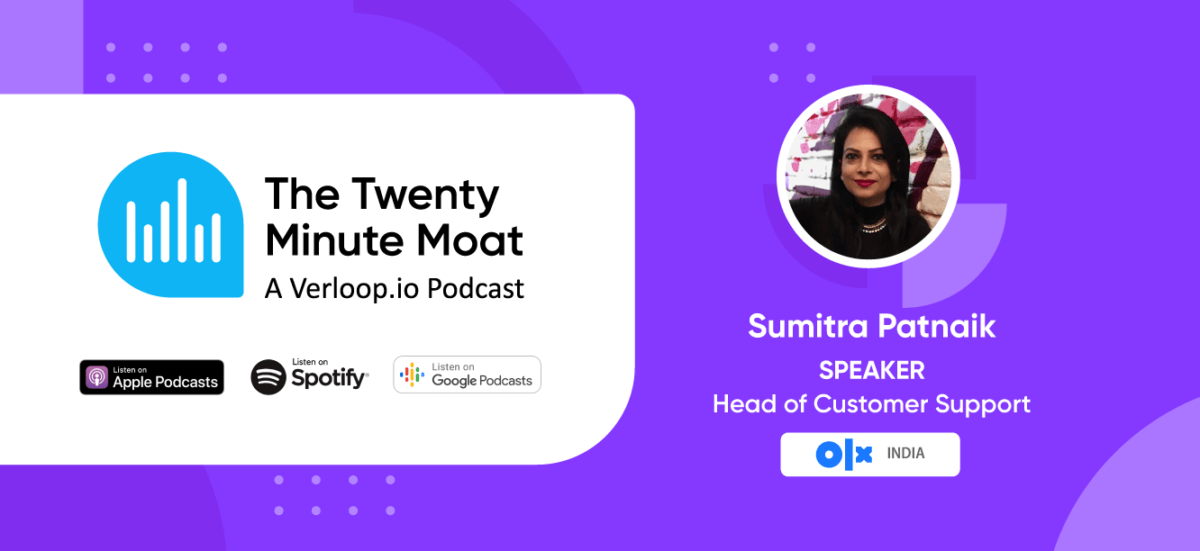Duration 18:14
Guest Speaker
Industry
Others
Athira S M heads the Customer Support and CX teams at Milaap and prior to this role, worked in business operations, marketing, and business development. Athira works with a young team to ensure that Milaap’s customers have a seamless experience across all touchpoints.
We cover:
- [01:01] How has the customer support space evolved
- [02:40] Major challenges faced in the past year
- [04:26] Is there a need to reimagine customer support
- [06:32] What customer support looks like at Milaap
- [08:26] Are users open to automated processes
- [11:20] How do you build delightful customer experiences
- [12:12] How will the customer support space evolve in the coming years
- [13:52] Will a combination of voice and chat-based conversational AI will be adopted in the future
Podcast Transcript
In this emotional intelligence and empathy for customer support podcast, we have Athira S M as our podcast guest and Siddharth Sharma as our podcast host.
Siddharth
Today we have a very special guest with us. We have Athira from Milaap. I’m sure everyone has heard of Milaap and we know Athira personally well. She has done a great amount of work and she’s been with Milaap for a very long time.
I can go on and on talking about Athira. But, Athira could you introduce yourself to our guests today?
Athira
Thank you Siddharth. I’m Athira. I head customer experience at Milaap.
I lead a young team of customer support and customer experience associates. I started off six years ago in Milaap and I joined as a customer associate. I moved to handle different functions like business operations, marketing and business development. As head of customer experience now, I handle the CX strategies and escalation management.
[01:01] Siddharth
Alright. Athira, while we will go into more details and we’ll talk more about customer support, Milaap has been very close to my heart. It’s been one of the places where I could, as a person, contribute to a lot of good causes.
I would like to hear your personal insights on the way this industry has evolved, is… specifically over the last couple of years.
Athira
I’ll give you a brief overview of how Milaap came into the picture. It was three young entrepreneurs who built this model, disrupting many traditional notions around giving. So giving was traditionally looked at as giving to a religious institution or to a non-profit. You know, with a business model like this, digital giving came into the picture. Like you could connect people who are in need to people who are looking for funds.
And, I think, what it established is giving to a stranger can be easy, can be safe, and as a donor who has supported a cause, who has helped a person, you have absolute power to track the impact of your donation.
You have the power to know what happened to your contribution. I think this is, you know, the basic ideology behind any crowdfunding and behind our platform. In the last few years, I think there have been a lot of awareness of crowd funding from individuals knowing the power of… you know, community outreach and the power or crowd funding to support causes like healthcare fundraiser or medical fundraisers, supporting causes like education, animal welfare.
So I think there’s a lot of awareness on crowdfunding, even though the industry as such is still evolving and the pandemic as such has caused a little more disruption and more awareness. More acceptance in… of digital giving and more engagement on the platform by both corporates and individuals.
[02:40] Siddharth
Got it, understood. I… I love this word that you just talk about, digital giving.
Can relate to that thought process where you said, initially it was all about giving it to either a religious institute or, you know, and… actually being physically there while giving and, you know, trusting a stranger was difficult. I think Milaap’s bridged that gap very well, at least from an anecdotal point of view.
So, what has been… from a Milaap perspective, where you have, you know, been a very core team member, what have been some of the major customer support challenges that you have faced in the last year?
Athira
Last year, I think 2020 was quite a milestone year for us, because we completed 10 years into the business.
We also took a leap of faith and launched us as a freak crowdfunding platform, and when COVID hit, we opened up our platform for COVID related fundraisers. We had individuals fundraising for courses starting from, you know, raising money for a friend who has lost his job, raising money for food and other essentials. Entrepreneurs raising money for the staff they couldn’t pay.
We had brands coming, tapping into our crowdfunding to support their community. All of this had an impact on… uh… the customer support space. Our volumes increased 4X.
Along with the volume, the customer emotion on the interactions, the level of emotion and the level of service demanded was more.
This required the customer support team members to… I think put their skills to best of use, their advocacy skills, their empathy to ensure that the concerns are addressed, the support is provided at the end of the day. This phase also brought out some amazing talent, leadership abilities, a great example set, you know, for the young members of the team by the founders when, you know, they decided to roll up their sleeves and support the frontline workers.
Talking to customers, you know, solving very basic queries. So, it brought out a lot of talent and leadership qualities.
A lot of changes that, you know, we never expected will happen in the customer support function within Milaap.
[04:26] Siddharth
You know, and you’ve been a very senior member in the customer support space, right? Do you feel there is a need right now to reimagine the way customer support has been done and how is it being done currently at Milaap and do you think there’s a way there… there is a need to reimagine the way it is done overall?
Athira
I think what is important to think about is, from where the need versus want is derived from, to reimagine or innovate.
I would bifurcate it this way. Need basis the nature of your business, the context of your business, where it is very critical that you constantly innovate. You constantly reimagine a particular function, like customer support. And then there’s need basis your larger environment or industry where competitiveness comes into the picture right? Where you have to constantly reimagine and innovate to gain a competitive advantage.
So, companies belonging to the second category, up until now, had the flexibility to prioritize basis resources and capital. I mean, it was not worrisome when a company chose not to, you know… and embrace innovation or automation, take an example, right? As long as they had another, you know, something else to leverage on.
They had a better competitive advantage. But the pandemic, I think, made this bifurcation, or, I would call it boundaries nonexistent. So it wasn’t about the survival of businesses or the industry itself. So everyone was forced to accelerate you know, their innovation, and especially in functions like customer support. And, when you look at customer service, customer support functions or industry, the service level dropped, either because of infrastructure-related challenges- your call centres couldn’t immediately move to a remote setting or the service level dropping because of capability issues.
You have volumes increased and your team is not sufficient to handle. That is something that happened with Milaap as well. So, I think, understanding this need to reimagine and what is the impact on that post-pandemic is very crucial. And overall, I think from an industry point of view as well, there’s a lot of acceptance to embracing technologies like automation, because they know that the volumes have increased, because they know there’s more awareness and involvement.
[06:32] Siddharth
And Athira, you know you… you folks have done such an amazing job at Milaap, right? I mean, I think, when you talked about, you know, how your team actually rolled up their sleeves and even… even right from the founders till every worker you know, rolled up their sleeves and talked to the people right, can you give us an idea about, you know, how customer service at Milaap looks like today?
Athira talks about their customer service
Sure, as I mentioned, I think in the beginning, it’s a very young team and we call them business Operation Associates because these folks are trained on the core Biz-ops activities as well because one of the traits that we look out for is they should have the ability to go, collaborate, discuss with cross-functional teams, research, and come back with the best solution.
A script, you know, with standard responses are no longer relevant. So, the customer support team, even though that’s the larger function, these individuals are looked at, you know… consultants or business Operation Associates who have knowledge of the product and also have cross-functional ability to collaborate cross-functionally.
So, right from, I think, once they are onboarded, that’s what the focus is and they have been given… we try to give them opportunities where they can explore, even if it… this would mean that in the quarter, along with their… uh… usual activities, they get to experience what another team, you know, what another team does, or, you know, how will… their work impact customer service. So they are given this exposure and the team also is very fluid in terms of handling different activities.
During the pandemic we had formed a task force where, apart from customer support, these folks were also involved in other core activities because… people were unable to make it to work.
They were sick. They formed a different task force. They started concentrating… we had created sub-teams. When our call volumes, had increased, we had folks who were primarily handling… uh… handling other channels move up and handle phone calls. We had senior leaders, or we had independent contributors work on… you know, channels like WhatsApp and email.
So, that’s how it’s generally structured. I think what the pandemic showed us is sort of gave us an opportunity to… you know showcase what they are trained for.
[08:26] Siddharth
This is so heartening to, you know, listen to right? And now I’ll come to a hypothetical situation. Do you believe that customers, specifically in your industry you just talked about, you know, a simple script or a simple FAQ, it doesn’t come to mettle, right? I mean it’s not a good experience for anyone.
But, if you are able to automate with the advanced ML and AI technology, which is coming into the picture, if you were able to automate, do you feel that your customers that you have currently and the customers… uh… queries that you get currently, do you feel your customers are still insisting on talking to a live agent, or at… will they be comfortable when they get their responses if an accurate response is given to them?
Athira talks about AI in customer service
Milaap. I think…uh… this is not a post pandemic situation. I think much before itself we understood the need to constantly, you know, innovate and embrace technologies like AI.
We… I think a few years ago we had automated our fundraiser setup process. So, an individual or an organization can set up a fundraiser in less than 5 minutes. If you are someone who is struggling to articulate because you are in such a situation that… you know, you can’t convey what you’re going through, but we need to set up a fundraiser, we had automated and created a story assistant that, you know, let’s you choose some options and create a story from there.
So that was just one part of the problem where… you know, inherently we feel… you know, the need to anticipate friction. Because… we are in a space where we deal with life or death situations. It’s about health care and medical fundraisers. So there was an inherent need for us to constantly see where we can… you know, save time… where we can provide a seamless experience. We have identified areas where customers are also comfortable to sort of embrace it, like fundraiser set up. I think our customers found it very useful to sort of set it up under 5 minutes.
Similarly, once you raise money, it has to be withdrawn, so it’s very crucial that it’s withdrawn to… for the intended purpose and to the intended person which is the beneficiary of the campaign.
So, earlier, these processes, including KYC verification, all of that were to be done manually. Now we have taken several steps to sort of automating that fully. Other instances would be ensuring that fraudulent activities are, you know, tracked… are identified much before. Making Milaap more safer place for our customers to engage in. So all of these kinds of reduced the queries coming into customer support regarding this. Queries such as ‘why should I trust Milaap’ or ‘when do I get the money?’, ‘how can I set up a campaign?’.
So, I think pretty much 95% of such queries decreased because we had done automation at these touch-points. So… and there were high adoption rates as well in these areas. But, like I said, we had automated the fundraiser setup process, but we still have a dedicated team…uh… available to just call up and set up campaigns. And this setup also helped the population which are not…I mean, low on digital literacy, I would say and would need multilingual support. I think for platforms like Milaap or the crowdfunding industry as such, sometimes… you know, we’ll have to think beyond scalability and usefulness. Think about what it would mean for the brand to adopt automation 100 percent.
[11:20] Siddharth
Completely agree with you on that point. And… you touched upon this and I wanted to expand a bit more, right? When it comes to chatbots, What do you think are the biggest shortcomings?
Athira
Taking a very specific example from the point that I just mentioned about multilingual support, I think localization of AI is still evolving. Localized chat bots, even though there are many platforms that offer, in the context of your business, if there is scope for scalability, I think that could be a challenge.
And when it comes to platforms like Milaap, emotional intelligence, empathy, and trust often leads the way for customer support team, right? Going above and beyond is getting norma… normalized because there is no… you know, one solution to the kind of… you know, queries that we get.
So, when you take industries or and you take businesses of that sort since the technology is still evolving, there are, you know, shortcomings that will make the leaders sort of question that if automation… 100%… is what is required by the Brand.
[12:12] Siddharth
I want to understand from your perspective, right, what do you think are the best practices when it comes to providing customers with a delightful experiences? What used to work and what works today.
I think you touched upon this in various answers, but like… uh… you know, being in a part of customer experience and, you know, leading the entire Milaap team, I want to get this from you, right?
How do you build delightful support experiences and how has that changed?
Athira talks about importance of customer support experience
I think it’s important to understand if your team, if your customer supports team understands the scope of customer delight, delight with their work. They should understand how they can move from providing customer satisfaction to customer delight.
I think that’s the first step. Customer supports teams should move from a more transactional relationship, a more transactional conversation, I would say, to a more relationship conversation and I think that is another interim step, you know, for them to achieve customer delight and one of the exercises that… you know, we recently tried to do is to identify…uh… or anticipate friction from your first interaction with the customer. It could be a knowledge related query, this could also… it could just purely be a relationship based query, but understanding or anticipating friction for that user in the next set of… you know, steps… interaction with the product, or… you know, what is the next step for that customer on the platform.
Based on the first interaction, if you can anticipate… this particular customer might have issues related to this, I think that is also a great way to provide end to end support. That will train your customer support teams to keep track of… you know, that customer, ensure that… you know, you… you realize that the customer delight might just lie outside closing off a ticket. I think these two are the essential steps that you can start internally to work towards customer delight.
[13:52] Siddharth
We’ve been picking your brains on customer support, but I’ll pick even more, right? Being a part of Milaap, and from the core team and from the ground up, and now there, heading the entire customer experience, how do you feel customer support will evolve over the next couple of years?
And I’m not going to say five years because… you know, now our visions being limited and the pandemic has shown us that, you know, all plans can go to the… you know, just go out to the window in a flash. But how do you feel customer support will evolve over the next two years?
Athira
There’ll be definitely accelerated innovation in customer support. Omni-channel support is already the trend and… more personalized, more systems and conversations, automated assistance. And I can also think about organizations having teams that will be more proactive in terms of… you know, customer… providing customer solutions.
Given that the customer support team is more reactive when a customer reaches out to you. We have a customer experience team. Apart from… you know, assisting with escalations
They would also understand… try to anticipate how can we prevent this from happening in the future, uh… or what is that that we need to work with the product team or any other team to ensure that we know the next time such a query comes, we manage it well.
So the creation of such teams… it could even be a complete… you know, revisiting of how customer support is reactive and not proactive, right, can also be relooking at having a more proactive support.
[15:13] Siddharth
And we’ve seen the role of conversational AI in the customer support space. And like you said, you know, it digitally transformed control… contact centers, right?
And it has helped the branch move to omnichannel support, right? Primarily these are mostly text-based or chat-based chatbots, right?
However, over a period of time voice is coming into the picture. Do you think a combination of voice and chat-based conversational AI will be adopted increasingly by brands, especially in the space of Milaap?
Athira
I think it’s a natural progression. Anyone who has an omnichannel presence and then who has already embraced the steps of AI would naturally… would want to explore voice-based chats or a combination of both voice and text. But within the context of Milaap, we had introduced a voice-based assistant back in 2019 for fundraiser set up.
And the learning from that was, it has to be looked at… you know, based on the scenario, very contextual. One-to-one sort of… you know, worked for us.
For example, sending a voice-based chat thank you note to a donor, instead of a text-based one. So these are interesting areas for us to explore.
But, again, the scope of that at all the touchpoints needs to be evaluated carefully.
[16:16] Siddharth
What’s your major pain point with the conversational AI providers of today? Like, if you had to tell them something right and tell them that ‘folks you’re doing this wrong’, what is that you will tell them?
Athira
I can, as a customer, talk about what challenges that I faced, you know, when one of our systems… when we had this… you know, chatbot introduced. Our customers reach out in different languages, the emotional state when they did reach out will not enable them to go in that sequence in which the chatbot is implemented.
Like you know you have this query. You have that query, sometimes it’s…a simple statement that… you know, ‘I want funds’ or ‘I need help’. Maybe the person will not even want to interact unless… you know, we probe further. So that has been one of the challenges, right… in the sequence in which… you know, you say that, OK, this is the query then this is the next flow.
Sometimes, the context in which the person is writing it cannot be standardized right? This second, I think is the users on Milaap. So I could be a campaign organizer, I can be a donor as well. So when I ask a question, right now our agents are looking into the conversation history. we know that OK, this person is coming from here, he is also this and he’s also that. And based on that context… you know, we’ll be able to just solve a query. So, if it’s… it’s not a narrow field, it’s not basic assistance, it’s much more complex when we talk about interactions in Milaap. So I think I see a challenge there.
Siddharth
Athira, it’s been great interacting with you over this podcast, and I think we’ve got some major learnings. And as a conversational AI provider, I think I couldn’t have asked for a better person to talk to today. Thank you so much. Thank you to all our listeners listening in.
Athira
Thank you, Siddharth. Thank you team Verloop for the opportunity.



